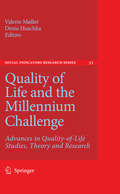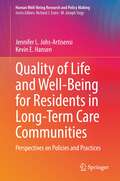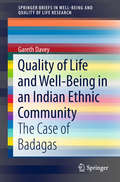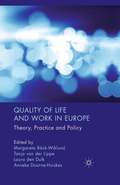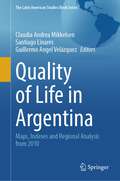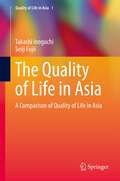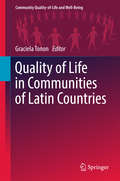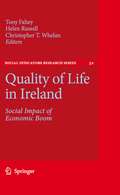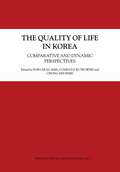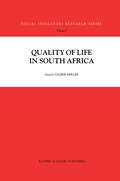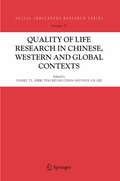- Table View
- List View
Quality of Life and Disability: An Approach for Community Practitioners
by Ivan Brown Roy Brown'A refreshing book that can hold the reader's interest throughout. Quality of Life and Disability should be a compulsory text for all students in the disability field and would make a useful one for experienced practitioners including social workers.' - Australian Social Work 'Among the recent proliferation of books on quality of life, this is a standout! Not only is Quality of Life and Disability: An Approach for Community Practitioners placed squarely in the disability field, but it has an applied emphasis that is rare for a topic that so abounds in vague and often conflicting theories and terminologies. Rather than burdening the reader with the conceptual conundrums of a construct as ambitious as whole of life quality, Brown and Brown dive into the real life issues. This quality of life text will appeal to many practitioners in the disability field. A welcome addition to the bookshelves of many practitioners.' - Paul Bramston, University of Southern Queensland, Australia 'Excellent guide demonstrating to practitioners, not only what they have to do to increase the quality of life of the people they look after, but also how they should start doing it.' - Wspolne Tematy 'A remarkably rich mixture of experience, guidance and insight into the determination of people's quality of life, and into ways in which a wide variety of care staff, managers and policy-makers can understand and respond to disabled people's wants and needs.' - Care and Health magazine 'One of the most refreshing approaches in the contemporary literature on quality of life and disability. The authors are to be congratulated for the very user friendly way the book has been designed.' - Trevor R. Parmenter, University of Sydney 'This book reflects the authors' extensive experience and admirable insight as they bring quality of life ideas closest to those who are in the best position to apply them - the practitioners. Useful, stimulating and well written.' - Robert L. Schalock, Hastings College, Nebraska 'The authors weave their text seamlessly, reminding us at every turn that quality of life varies across individuals, cultures and time... tightly-structured and practical.' - Patricia Noonan Walsh, University College, Dublin 'This excellent book is a valuable contribution to training literature in the field of community rehabilitation.' - Mitchell Clark, Mount Royal College, Calgary, Canada Quality of life - physical, psychological and environmental well-being - is a crucial consideration for professionals working with people with a disability. The authors of this practical book apply ideas about quality of life to the field of disability to assist front-line professionals, managers and policy-makers in effective service provision. They examine the historical context of the concept of quality of life and discuss the application of quality of life in the daily lives of people who have disabilities. Using recent studies to show how the development of quality of life approaches have led to changes in rehabilitation, and how an understanding of the issue can inform practice in assessment, intervention, management and policy, this is an indispensable book for all practitioners and managers working with people with disabilities.
Quality of Life and Disability: An Approach for Community Practitioners (PDF)
by Ivan Brown Roy Brown'A refreshing book that can hold the reader's interest throughout. Quality of Life and Disability should be a compulsory text for all students in the disability field and would make a useful one for experienced practitioners including social workers.' - Australian Social Work 'Among the recent proliferation of books on quality of life, this is a standout! Not only is Quality of Life and Disability: An Approach for Community Practitioners placed squarely in the disability field, but it has an applied emphasis that is rare for a topic that so abounds in vague and often conflicting theories and terminologies. Rather than burdening the reader with the conceptual conundrums of a construct as ambitious as whole of life quality, Brown and Brown dive into the real life issues. This quality of life text will appeal to many practitioners in the disability field. A welcome addition to the bookshelves of many practitioners.' - Paul Bramston, University of Southern Queensland, Australia 'Excellent guide demonstrating to practitioners, not only what they have to do to increase the quality of life of the people they look after, but also how they should start doing it.' - Wspolne Tematy 'A remarkably rich mixture of experience, guidance and insight into the determination of people's quality of life, and into ways in which a wide variety of care staff, managers and policy-makers can understand and respond to disabled people's wants and needs.' - Care and Health magazine 'One of the most refreshing approaches in the contemporary literature on quality of life and disability. The authors are to be congratulated for the very user friendly way the book has been designed.' - Trevor R. Parmenter, University of Sydney 'This book reflects the authors' extensive experience and admirable insight as they bring quality of life ideas closest to those who are in the best position to apply them - the practitioners. Useful, stimulating and well written.' - Robert L. Schalock, Hastings College, Nebraska 'The authors weave their text seamlessly, reminding us at every turn that quality of life varies across individuals, cultures and time... tightly-structured and practical.' - Patricia Noonan Walsh, University College, Dublin 'This excellent book is a valuable contribution to training literature in the field of community rehabilitation.' - Mitchell Clark, Mount Royal College, Calgary, Canada Quality of life - physical, psychological and environmental well-being - is a crucial consideration for professionals working with people with a disability. The authors of this practical book apply ideas about quality of life to the field of disability to assist front-line professionals, managers and policy-makers in effective service provision. They examine the historical context of the concept of quality of life and discuss the application of quality of life in the daily lives of people who have disabilities. Using recent studies to show how the development of quality of life approaches have led to changes in rehabilitation, and how an understanding of the issue can inform practice in assessment, intervention, management and policy, this is an indispensable book for all practitioners and managers working with people with disabilities.
Quality of Life and Early British Migration (SpringerBriefs in Well-Being and Quality of Life Research)
by Thomas JordanThis book discusses the quality of life of early modern Britons emigrating to the New World, which became possible with advances in shipbuilding and long-distance sailing. It examines the status and quality of life of those crossing the Atlantic Ocean under legal contract, the indenture – largely to the Carolinas and the communities adjoining Chesapeake Bay in the USA in the 17th century, and also describes and numerically estimates the quality of life among Britons sentenced to “transportation beyond the seas,” who were transported to Australia in the mid-19th century. The author examines the experience of migrants, both adults and children, traveling to the New World and their fate, drawing on documentary sources like state historical records as well as self-documentation from the few surviving diaries. The book also creates profiles of the quality of life of emigrants by gender and age and places the processes of emigration in the social–political contexts of the 17th and 19th centuries.By considering ways in which aspects of social life were organized in eras before structural inquiry into the quality of life, the book provides interesting historical perspectives as well as methodological insights. It appeals to researchers and students interested in the quality of life and wellbeing, and in the history of modern Europe, particularly of the British Empire.
The Quality of Life and Policy Issues among the Middle East and North African Countries (Human Well-Being Research and Policy Making)
by el-Sayed el-AswadThis book addresses the challenges threatening the quality of life and well-being of people living in the MENA region. It focuses on both internal / local and external / global drivers impacting their well-being particularly in the domains of economy, health, and education. Additionally, it presents a critical analysis to help readers understand the position that the MENA countries currently occupy in the world. Lastly, it provides policy analysts and decision makers with otherwise hard to obtain data and information related to socio-economic, cultural, demographic, technological, and political factors that have influenced the quality of life there.
Quality of Life and the Millennium Challenge: Advances in Quality-of-Life Studies, Theory and Research (Social Indicators Research Series #35)
by Denis Huschka Valerie MøllerThe new millennium is widely considered to be the age of globalisation, democratisation, and human rights. We live in a knowledge society and in a time of risk and uncertainty. World society is rapidly urbanising and ageing and exhausting its natural resources. It is the interplay of such key trends of the era that calls for a fresh approach to measuring quality of life. This collection of papers presents an innovative approach to evaluating living standards and wellbeing under the new circumstances facing individuals and societies in twenty-first century. Contributions cover a wide range of issues that impact positively and negatively on wellbeing in our age. While stability, trust, equal access to resources and the social integration of disadvantaged members of society enhance well-being, poverty, social exclusion, congestion in cities, HIV/AIDS and global warming pose threats to both modern and traditional lifestyles. Methodological refinements of conventional measurement tools are presented that take into consideration the rich diversity of lifestyles and values among different populations and regions of the world. This book will be essential reading for social scientists and ordinary citizens who are concerned about the future of human well-being on our planet.
Quality of Life and Well-Being for Residents in Long-Term Care Communities: Perspectives on Policies and Practices (Human Well-Being Research and Policy Making)
by Kevin E. Hansen Jennifer L. Johs-ArtisensiThis book explores key factors long-term care recipients have identified as impacting their quality of life and offers programmatic and policy recommendations to enhance well-being within long-term care communities. Leadership and staff who work in nursing homes and other residential care communities serve as gatekeepers to resident well-being, often without recognizing how residents’ quality of life is impacted by their decision-making. This book takes a life domain approach to build on research-based studies that document key drivers of care recipients’ quality of life, including relationships, autonomy and respect, activities and meals, environment, and care. Using a framework that enhances understanding of resident quality of life, it outlines practical, programmatic, and policy suggestions for long-term care stakeholders, such as administrators, managers, front-line staff, family members, and policy-makers, whose directives and actions impact the lived experience of long-term care residents. As such, this book serves as a roadmap for leaders and managers of long-term care communities, along with policymakers who regulate health and human services, to best structure care environments to maximize quality of life and well-being for long-term care recipients.
Quality of Life and Well-Being in an Indian Ethnic Community: The Case of Badagas (SpringerBriefs in Well-Being and Quality of Life Research)
by Gareth DaveyThis book explores the quality of life among Badagas, an ethnic minority group in South India, as they navigate a society in flux, with specific reference to rural-to-urban migration and new media. At an empirical level, it reveals how Badagas understand themselves and the multifaceted changes in their culture and daily lives, exploring a pertinent concern at the forefront of debate about the future from a global perspective. The book draws attention to the fact that people are adopting flexible identities and lifestyles in an attempt to survive and thrive in a changing India and world, a new ‘Indian-ness’ shaped at the local level. It offers a timely update on previous research on Badagas, which dates to the 1990s, and also serves as an important case study on people’s experiences of the social and economic transformation of Indian society as they become accustomed to new ideas, products, and ways of life. As such, it is a must-read for all those interested in quality of life in India and developing societies.
Quality of Life and Work in Europe: Theory, Practice and Policy
by Margareta B�ck-Wiklund, Tanja van der Lippe, Laura den Dulk and Anneke van Doorne-HuiskesIntense globalization, rapidly changing workplaces and family patterns have renewed the international interest in quality of life. This book examines different institutional arrangements, work-place conditions and gendered work and care that affect the conditions for achieving quality of work and life in European countries.
Quality of Life Impairment in Schizophrenia, Mood and Anxiety Disorders: New Perspectives on Research and Treatment
by A. George AwadA fascinating and worthy text that presents new insights into a hugely important area of mental health. Health-related quality of life (HRQL) impairment is a core domain of prevalent mental disorders such as schizophrenia, schizoaffective, mood and anxiety disorders. The authors present a new conceptual framework for this field by explaining how HRQL impairment arises from interactions between various multidimensional factors. They suggest several ways in which further research could enhance our understanding of HRQL impairment, its biological basis, and its relevance to psychopathology.
Quality of Life in Argentina: Maps, Indexes and Regional Analysis from 2010 (The Latin American Studies Book Series)
by Claudia Andrea Mikkelsen Santiago Linares Guillermo Angel VelázquezThis book studies inequalities in the quality of life of the Argentine population at the regional level. It considers the six regions of the National Statistical System: Northwest, Northeast, Cuyo, Pampa, Metropolitan, and Patagonia. A series of thematic maps is provided and interpreted, which are related to: a. socioeconomic issues (education, health, housing) and b. environmental aspects (environmental problems and recreational resources). These dimensions (socioeconomic and environmental) are integrated into quality of life indexes that allow the comparison of the situation of the population residing in any region of the national territory.
The Quality of Life in Asia: A Comparison of Quality of Life in Asia (Quality of Life in Asia #1)
by Takashi Inoguchi Seiji FujiiThis book studies and compares quality of life in 29 countries/societies in Asia: Afghanistan, Bangladesh, Bhutan, Brunei, Cambodia, China, Hong Kong, India, Indonesia, Japan, Kazakhstan, Kyrgyzstan, Korea(South), Laos, Malaysia, Maldives, Mongolia, Myanmar, Nepal, Pakistan, the Philippines, Singapore, Sri Lanka, Taiwan, Tajikistan, Thailand, Turkmenistan, Uzbekistan, and Vietnam. We utilize the AsiaBarometer Surveys conducted annually from 2003 through 2008. We focus on the notion of subjective quality of life and conceptualize it as two levels, global and domain. After we explain about the AsiaBarometer Survey Project, we explore current country profile, demographics, lifestyles, value priorities, specific life domain assessment and overall quality of life. We then estimate the independent effects of demographics, lifestyles, value priorities, life domain assessment on the overall quality of life within each society. As well as comparing the results between nations, we look for key generalized characteristics of life quality for the entire and sub-regions of Asia.
Quality of Life in Communities of Latin Countries (Community Quality-of-Life and Well-Being)
by Graciela TononThis book presents a reconfiguration of the concepts of community in Latin countries as well as the community quality of life and well-being of different groups: children, young people, older adults, migrants. The traditional concept of community has changed together with the way people participate in community spaces. Community nowadays is more than a geographic concentration; it is related to social support, inter-subjectivity, participation, consensus, common beliefs, joint effort aiming at a major objective, and intense and extensive relationships. This volume presents unique experiences about culture, social development, health, water, armed conflicts, the digital media, and sports within communities, written by authors from Latin countries. This volume is a valuable resource for researchers, students, and policy makers in quality of life studies.
Quality of Life in Ireland: Social Impact of Economic Boom (Social Indicators Research Series #32)
by Tony Fahey Helen Russell Christopher T. WhelanFrances Ruane, Director, Economic and Social Research Institute Irish and international scholars continue to be curious about Ireland’s exceptional economic success since the early 1990s. While growth rates peaked at the turn of the millennium, they have since continued at levels that are high by any current international or historical Irish measures. Despite differences of view among Irish economists and policymakers on the relative importance of the factors that have driven growth, there is widespread agreement that the process of globalisation has contributed to Ireland’s economic development. In this context, it is helpful to recognise that globalisation has created huge changes in most developed and developing countries and has been associated, inter alia, with reductions in global income disparity but increased income disparity within individual countries. This book reflects on how, from a social perspective, Ireland has prospered over the past decade. In that period we have effectively moved from being a semi-developed to being a developed economy. While the book’s main focus is on the social changes induced by economic growth, there is also recognition that social change has facilitated economic growth. Although many would regard the past decade as a period when economic and social elements have combined in a virtuous cycle, there is a lingering question as to the extent to which we have better lives now that we are economically ‘better off’.
The Quality of Life in Korea: Comparative and Dynamic Perspectives (Social Indicators Research Series #14)
by Doh Chull Doh Chull Shin Conrad P. Rutkowski Chong-Min Chong-Min ParkThis is the first volume ever published to examine the objective and subjective qualities of Korean life from both comparative and dynamic perspectives. It presents non-Western policy alternatives to enhancing the quality of citizens' lives, distinguishing Korea as an Asian model of economic prosperity and political democracy. It is intended for academics and policymakers interested in recent developments in Korea.
Quality of Life in South Africa (Social Indicators Research Series #1)
by ValerieMøllerSouth Africa's peaceful transition to democracy has gained it world recognition. This book gives a frank report on contemporary South African society and the challenges which the new nation faces. Sixteen social scientists, experts in fields as wide-ranging as economics, politics, and development planning, have compiled a social report on South Africa two years into democracy. The volume covers critical concerns which impact on the well-being of the average South African. The dozen chapters in the book present facts and figures as well as in-depth commentary on social issues which South Africa must address. The authors discuss the legacies of the past, including poverty and social inequality; problems of transition ranging from trauma to crime; and the hopes for the future which lie in economic growth and development, a deeper understanding of democracy, and a healthy dose of optimism. The book draws on information from a wide variety of sources including government statistics, independent social surveys, community research, and opinion polls. This rich data weaves a tapestry of the quality of life in South Africa for Africa watchers and the general public.
Quality of Life Research: A Critical Introduction (PDF)
by Professor Mark Rapley`Many books have been published on quality of life research in recent years, but few are as thought provoking or original as this one. It is essential reading for anyone who a serious and critical interest in this topic' - Nurse Researcher `This was a fun book to read and I would suggest it be used for a graduate level seminar - where, of course, it would lead to a lively discussion' - Quality of Life Research `Quality of life' is one of the fastest growing areas of research and policy. The concept has an intuitive appeal as a measure of the well-being of individuals, communities and nations. It is increasingly promoted as an aid for political decisions and public funding. But what does the concept really mean? And how can it be operationalized in teaching and research? This is the first introductory text to offer a critical overview of the concept of quality of life and the ways in which it is researched. Using an inter-disciplinary approach, the book covers every aspect of the concept and its application - from the calculation of Quality-Adjusted Life Years to conversation analysis, and from the estimation of the quality of life of nation states to ethnographic studies of the life quality of individual disadvantaged people. The book fills a huge gap in teaching and research. Written with authority, and the need to produce an accessible critical introduction to the field, it will be of interest to students of sociology, psychology, public health and nursing, health economics, politics and medicine.
Quality-of-Life Research in Chinese, Western and Global Contexts (Social Indicators Research Series #25)
by Ying Keung Chan Paul S. N. Lee Daniel T. L. ShekThe majority of studies on the quality of life have been conducted in Western contexts and are based on Western participants. Comparatively speaking, there are only a few studies that have been conducted in different Chinese contexts. Also, there are fewer QOL studies based on children and adolescents, or studies that examine the relationship between QOL and economic disadvantage. In addition, more research is needed to address the methodological issues related to the assessment of quality of life. This volume is a constructive response to the challenges described above. It is the first book to cover research in Chinese, Western and global contexts in a single volume. It is a ground-breaking volume in which Chinese studies on the quality of life are collected. The book includes papers addressing family QOL, quality of life in adolescents experiencing economic disadvantage, and methodological issues in the assessment of QOL. It is written by researchers working in a variety of disciplines.
The Quality of Qualitative Research
by Clive Seale`Apart from its inherent readability, I found three other attractive features about the book: First is the use of exemplars based on case studies from qualitative studies, including Whyte's Street Corner Society; second, is the quotes from key methodological texts reflecting on a range of qualitative research traditions; and third, is the use of philosophical argument and reference in the book which provided an added depth to the debate, often lacking in more practically oriented books. These deliberations take readers to a higher plane, whilst still allowing the novice to philosophy to gain an insight into theory' - Forum for Qualitative Research `Seale steers a dispassionate course - both pragmatic and thoughtful - through the sometimes stormy waters of qualitative analysis. Anyone wanting an up-to-date picture of qualitative analysis will benefit from this book. It is truly a quality contribution to the field' - Nigel Fielding, University of Surrey `Clearly and engagingly written, this book covers crucially important issues such as the generalisability of findings, the grounding of theory and the validity and reliability of research reports. With frequent summaries of key points, criteria for evaluating research reports and discussions exercises, this is an extremely useful text for students and professionals alike' - Derek Layder, University of Leicester `This is a brilliant, carefully crafted, even-handed, comprehensive analysis of the multiple ways in which quality is assessed in contemporary qualitative inquiry. Clive Seale provides a balanced, subtly nuanced treatment of this key problem' - Norman Denzin, University of Illinois, Urbana-Chanpaign `The coverage is impressive and the depth of scholarship impeccable. Both students and seasoned investigators will find the author's pragmatic approach refreshing and helpful. It will appeal to the naturalistic researcher as well as to empirically-oriented scholars smitten by postmodern questions. I would definitely recommend it to my students. A splendid leading text for classroom adoption' - Jaber F Gubrium, University of Florida `Clive Seale has performed an important service for social science researchers by finding a sane middle ground between the twin fanaticisms of radical interpretivism and quantiative scientism. His book is practical, telling people who want to get research done how to do that in an effective and reasonable way. His explanations are clear and concise, his examples well chosen, and the practices he recommends are doable. You can learn a lot about how to approach research from this book' - Howard S Becker, University of California, Santa Barbara `For the undergraduate, or postgraduate looking for a comfortable drive through an increasingly unmanageable literature, this book provides an outstanding introduction' - Qualitative Research
The Quality of Qualitative Research (PDF)
by Clive Seale`Apart from its inherent readability, I found three other attractive features about the book: First is the use of exemplars based on case studies from qualitative studies, including Whyte's Street Corner Society; second, is the quotes from key methodological texts reflecting on a range of qualitative research traditions; and third, is the use of philosophical argument and reference in the book which provided an added depth to the debate, often lacking in more practically oriented books. These deliberations take readers to a higher plane, whilst still allowing the novice to philosophy to gain an insight into theory' - Forum for Qualitative Research `Seale steers a dispassionate course - both pragmatic and thoughtful - through the sometimes stormy waters of qualitative analysis. Anyone wanting an up-to-date picture of qualitative analysis will benefit from this book. It is truly a quality contribution to the field' - Nigel Fielding, University of Surrey `Clearly and engagingly written, this book covers crucially important issues such as the generalisability of findings, the grounding of theory and the validity and reliability of research reports. With frequent summaries of key points, criteria for evaluating research reports and discussions exercises, this is an extremely useful text for students and professionals alike' - Derek Layder, University of Leicester `This is a brilliant, carefully crafted, even-handed, comprehensive analysis of the multiple ways in which quality is assessed in contemporary qualitative inquiry. Clive Seale provides a balanced, subtly nuanced treatment of this key problem' - Norman Denzin, University of Illinois, Urbana-Chanpaign `The coverage is impressive and the depth of scholarship impeccable. Both students and seasoned investigators will find the author's pragmatic approach refreshing and helpful. It will appeal to the naturalistic researcher as well as to empirically-oriented scholars smitten by postmodern questions. I would definitely recommend it to my students. A splendid leading text for classroom adoption' - Jaber F Gubrium, University of Florida `Clive Seale has performed an important service for social science researchers by finding a sane middle ground between the twin fanaticisms of radical interpretivism and quantiative scientism. His book is practical, telling people who want to get research done how to do that in an effective and reasonable way. His explanations are clear and concise, his examples well chosen, and the practices he recommends are doable. You can learn a lot about how to approach research from this book' - Howard S Becker, University of California, Santa Barbara `For the undergraduate, or postgraduate looking for a comfortable drive through an increasingly unmanageable literature, this book provides an outstanding introduction' - Qualitative Research
The Quality of the Archaeological Record
by Charles PerreaultPaleobiology struggled for decades to influence our understanding of evolution and the history of life because it was stymied by a focus on microevolution and an incredibly patchy fossil record. But in the 1970s, the field took a radical turn, as paleobiologists began to investigate processes that could only be recognized in the fossil record across larger scales of time and space. That turn led to a new wave of macroevolutionary investigations, novel insights into the evolution of species, and a growing prominence for the field among the biological sciences. In The Quality of the Archaeological Record, Charles Perreault shows that archaeology not only faces a parallel problem, but may also find a model in the rise of paleobiology for a shift in the science and theory of the field. To get there, he proposes a more macroscale approach to making sense of the archaeological record, an approach that reveals patterns and processes not visible within the span of a human lifetime, but rather across an observation window thousands of years long and thousands of kilometers wide. Just as with the fossil record, the archaeological record has the scope necessary to detect macroscale cultural phenomena because it can provide samples that are large enough to cancel out the noise generated by micro-scale events. By recalibrating their research to the quality of the archaeological record and developing a true macroarchaeology program, Perreault argues, archaeologists can finally unleash the full contributive value of their discipline.
The Quality of the Archaeological Record
by Charles PerreaultPaleobiology struggled for decades to influence our understanding of evolution and the history of life because it was stymied by a focus on microevolution and an incredibly patchy fossil record. But in the 1970s, the field took a radical turn, as paleobiologists began to investigate processes that could only be recognized in the fossil record across larger scales of time and space. That turn led to a new wave of macroevolutionary investigations, novel insights into the evolution of species, and a growing prominence for the field among the biological sciences. In The Quality of the Archaeological Record, Charles Perreault shows that archaeology not only faces a parallel problem, but may also find a model in the rise of paleobiology for a shift in the science and theory of the field. To get there, he proposes a more macroscale approach to making sense of the archaeological record, an approach that reveals patterns and processes not visible within the span of a human lifetime, but rather across an observation window thousands of years long and thousands of kilometers wide. Just as with the fossil record, the archaeological record has the scope necessary to detect macroscale cultural phenomena because it can provide samples that are large enough to cancel out the noise generated by micro-scale events. By recalibrating their research to the quality of the archaeological record and developing a true macroarchaeology program, Perreault argues, archaeologists can finally unleash the full contributive value of their discipline.
The Quality of the Archaeological Record
by Charles PerreaultPaleobiology struggled for decades to influence our understanding of evolution and the history of life because it was stymied by a focus on microevolution and an incredibly patchy fossil record. But in the 1970s, the field took a radical turn, as paleobiologists began to investigate processes that could only be recognized in the fossil record across larger scales of time and space. That turn led to a new wave of macroevolutionary investigations, novel insights into the evolution of species, and a growing prominence for the field among the biological sciences. In The Quality of the Archaeological Record, Charles Perreault shows that archaeology not only faces a parallel problem, but may also find a model in the rise of paleobiology for a shift in the science and theory of the field. To get there, he proposes a more macroscale approach to making sense of the archaeological record, an approach that reveals patterns and processes not visible within the span of a human lifetime, but rather across an observation window thousands of years long and thousands of kilometers wide. Just as with the fossil record, the archaeological record has the scope necessary to detect macroscale cultural phenomena because it can provide samples that are large enough to cancel out the noise generated by micro-scale events. By recalibrating their research to the quality of the archaeological record and developing a true macroarchaeology program, Perreault argues, archaeologists can finally unleash the full contributive value of their discipline.
The Quality of the Archaeological Record
by Charles PerreaultPaleobiology struggled for decades to influence our understanding of evolution and the history of life because it was stymied by a focus on microevolution and an incredibly patchy fossil record. But in the 1970s, the field took a radical turn, as paleobiologists began to investigate processes that could only be recognized in the fossil record across larger scales of time and space. That turn led to a new wave of macroevolutionary investigations, novel insights into the evolution of species, and a growing prominence for the field among the biological sciences. In The Quality of the Archaeological Record, Charles Perreault shows that archaeology not only faces a parallel problem, but may also find a model in the rise of paleobiology for a shift in the science and theory of the field. To get there, he proposes a more macroscale approach to making sense of the archaeological record, an approach that reveals patterns and processes not visible within the span of a human lifetime, but rather across an observation window thousands of years long and thousands of kilometers wide. Just as with the fossil record, the archaeological record has the scope necessary to detect macroscale cultural phenomena because it can provide samples that are large enough to cancel out the noise generated by micro-scale events. By recalibrating their research to the quality of the archaeological record and developing a true macroarchaeology program, Perreault argues, archaeologists can finally unleash the full contributive value of their discipline.
The Quality of the Archaeological Record
by Charles PerreaultPaleobiology struggled for decades to influence our understanding of evolution and the history of life because it was stymied by a focus on microevolution and an incredibly patchy fossil record. But in the 1970s, the field took a radical turn, as paleobiologists began to investigate processes that could only be recognized in the fossil record across larger scales of time and space. That turn led to a new wave of macroevolutionary investigations, novel insights into the evolution of species, and a growing prominence for the field among the biological sciences. In The Quality of the Archaeological Record, Charles Perreault shows that archaeology not only faces a parallel problem, but may also find a model in the rise of paleobiology for a shift in the science and theory of the field. To get there, he proposes a more macroscale approach to making sense of the archaeological record, an approach that reveals patterns and processes not visible within the span of a human lifetime, but rather across an observation window thousands of years long and thousands of kilometers wide. Just as with the fossil record, the archaeological record has the scope necessary to detect macroscale cultural phenomena because it can provide samples that are large enough to cancel out the noise generated by micro-scale events. By recalibrating their research to the quality of the archaeological record and developing a true macroarchaeology program, Perreault argues, archaeologists can finally unleash the full contributive value of their discipline.
The Quality of the Archaeological Record
by Charles PerreaultPaleobiology struggled for decades to influence our understanding of evolution and the history of life because it was stymied by a focus on microevolution and an incredibly patchy fossil record. But in the 1970s, the field took a radical turn, as paleobiologists began to investigate processes that could only be recognized in the fossil record across larger scales of time and space. That turn led to a new wave of macroevolutionary investigations, novel insights into the evolution of species, and a growing prominence for the field among the biological sciences. In The Quality of the Archaeological Record, Charles Perreault shows that archaeology not only faces a parallel problem, but may also find a model in the rise of paleobiology for a shift in the science and theory of the field. To get there, he proposes a more macroscale approach to making sense of the archaeological record, an approach that reveals patterns and processes not visible within the span of a human lifetime, but rather across an observation window thousands of years long and thousands of kilometers wide. Just as with the fossil record, the archaeological record has the scope necessary to detect macroscale cultural phenomena because it can provide samples that are large enough to cancel out the noise generated by micro-scale events. By recalibrating their research to the quality of the archaeological record and developing a true macroarchaeology program, Perreault argues, archaeologists can finally unleash the full contributive value of their discipline.



